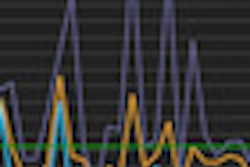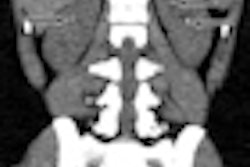A San Diego imaging center was able to reduce CT radiation dose by as much as 90% using a combination of dose reduction strategies with or without iterative reconstruction techniques, thus minimizing patient risk, researchers wrote in the November Journal of the American College of Radiology.
The group focused on CT scans of the chest, abdomen, and pelvis because these are the most frequently performed studies, as well as the ones with the highest radiation dose, wrote Dr. John Johnson and Dr. Jon Robins (JACR, November 2012, Vol. 9:11, pp. 808-813).
The center ended up revising every one of its CT imaging protocols using one or more of the following techniques:
Decreased peak kilovoltage: Peak kV is the single most powerful dose reduction tool because its relationship to dose is nonlinear, the authors wrote. For diagnostic chest CT and CT angiography exams, kV was reduced from 120 to 100 for patients with a body mass index (BMI) less than 30 kg/m2. For CT of the abdomen and pelvis, 100 kV was used for patients with BMI less than 25 kg/m2. Dedicated liver, renal, and pancreas protocols remain at 120 kVp.
Low-dose automatic dose modulation: CT scanners are all set by default to standard auto mA, then further adjusted by setting the noise index until image quality starts to erode. Image noise was increased by adjusting standard deviation in Toshiba Medical Systems scanners and noise index in GE Healthcare scanners, and the new settings were then programmed as defaults for each protocol.
Decreased coverage length: The researchers carefully defined stop and start points for each protocol and educated the technologists. Abdominal/pelvic CT should cover the top of the diaphragm to the inferior symphysis pubis. The renal protocol covers the top of the kidneys to the symphysis. CT pulmonary angiography scans should run from the lung apex to the costophrenic angle.
Pitch: The faster the pitch, the lower the dose. Radiologists should use the highest pitch that enables diagnostic image quality, ideally greater than 1.
Iterative reconstruction and noise reduction software: Iterative reconstruction is an expensive but highly effective way to cut dose by 40% to 50%. Third-party vendors also offer less costly options that are equally effective.
Other tips: Limit multiphase and double scans, and use low-dose scans for follow-up and CT-guided biopsies.
Implementing a comprehensive dose reduction program requires dedication, leadership, and commitment, the authors wrote. Key factors include a lead CT technologist, a CT applications specialist, a continuous feedback loop, and systems for educating staff members, Johnson and Robins wrote.
"It is possible to perform high-quality CT at a fraction of the radiation dose previously thought possible," Johnson said in a statement. "Using a combination of dose reduction strategies with or without iterative reconstruction, risks can be minimized, thereby ensuring the health and welfare of our patients."




















